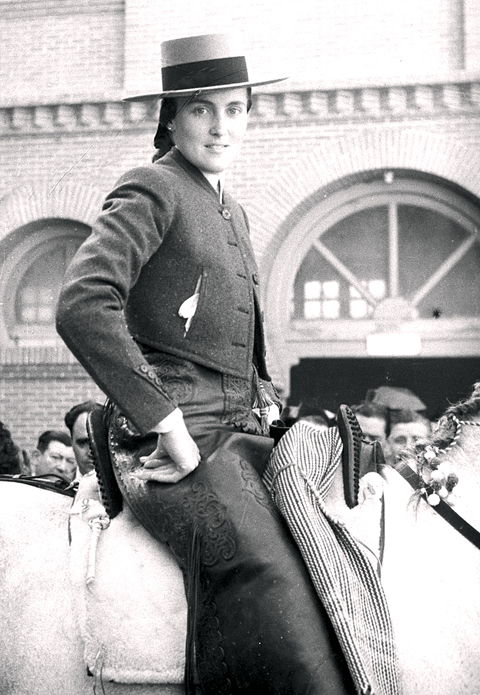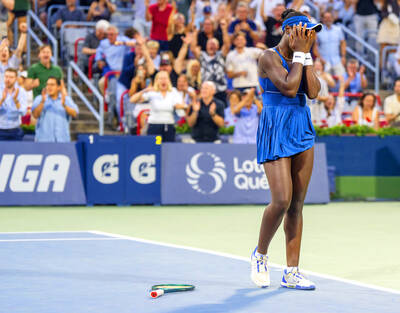A headline in the New York Sun on Sept. 4, 1940, captured accurately, albeit with amused condescension, the startling anomaly embodied by Conchita Cintron: “She’s a Timid Blue Eyed Girl But — She Kills Bulls Without Qualms.”
Cintron was 18 years old then and, as the headline went on to announce, had never been on a date, but she was already an international star of the bullring, a prodigy who was on her way to becoming perhaps the most celebrated torera in history. She was known as la Diosa Rubia, the “Blonde Goddess.”
“I have never had any qualms about it,” she said of her deadly skill in the article. “A qualm or a cringe before 1,200 pounds of enraged bull would be sure death.”

PHOTO: AP
Cintron, who retired from bullfighting after having killed as many as 750 bulls in the ring, died in Lisbon on Tuesday. She was 86.
The cause of death was a heart attack, family members told the Portuguese news agency Lusa. Her death and burial were confirmed by a funeral agency and a local church, The Associated Press (AP) reported.
“She made an indelible mark on a period of bullfighting history,” Hugo Ferro, of the Portuguese Bullfighters’ Union, said in an interview with AP.
Cintron, an expert horsewoman and a dedicated athlete who was known for her seriousness of purpose and serene manner, was unusual in that she mastered two styles of bullfighting: Spanish, in which the matador (or matadora, in her case) is on foot, and Portuguese, in which the bullfighter is on horseback and known as a rejoneador or rejoneadora. She was one of the very few — if not the only, as some reports said — who used both styles in the same fight, opposing the bull first on foot, giving it a series of cape passes; then on horseback, from which she provoked the bull with short, barbed sticks; and finally making the kill, once again on foot.
She was injured many times in the ring and seriously gored twice, once in each thigh; both times she fought on and killed the bull. She described the technique of killing a bull in an interview with AP in 1940.
“The bull to a certain extent commits suicide when he charges,” she said. “There is a little spot just forward of the shoulders which is not exposed to the matador’s sword unless the bull is charging.”
She continued: “No, it doesn’t take great strength to kill a bull. It does take a keen eye, a steady nerve and a true hand. But if the sword strikes the proper spot, it penetrates easily.”
She was born Concepcion Cintron Verrill in Antofagasta, Chile, on Aug. 9, 1922. Her parents were American. Her father, Frank Cintron, was from Puerto Rico, a graduate of West Point and for a time a career Army officer before becoming a businessman in South America. Her mother, Loyola Verrill, was from Connecticut; in 1960 she wrote a book about her daughter’s life, Goddess of the Bullring, under the name Lola Verrill.
When Cintron was still an infant, the family moved to Lima, Peru, where she grew up and where she came under the tutelage of Ruy da Camara, once a renowned rejoneador, who had just opened a riding school. He was taken with her, then age 11. She became his prize pupil, and in the early years of her international travel he was her chaperon. “My maestro,” she called him throughout her life.
Da Camara also tutored her in fighting bulls on foot — and killing them. She entered the bullring for the first time in Portugal at 13; she killed her first bull, in Tarma, Peru, at 15. When her autobiography, Memoirs of a Bullfighter, was published in 1968, an article in Vogue described how she got used to the idea of killing by practicing at a slaughterhouse, for days on end jabbing in vain at doomed oxen with a dagger.
“Day after day, sick at the gore, she went back to stab at more animals who bellowed and did not die,” the Vogue reporter, Robert Daley, wrote. “A friend told her she was closing her eyes with each stroke and thus missing the vital spinal gap behind the horns; she hated the idea of killing as much as that. She determined to kill that day’s six oxen with six strokes, keeping her eyes open, or give up bullfighting. She killed them each instantly, painlessly, and returned to Lima, singing.”
In 1949, Cintron, who had fought in Mexico, Peru, Venezuela, Colombia, Ecuador, Portugal, Spain and France, declared she would give up bullfighting to get married if she should find a suitable man, an intellectual “who can dominate me,” she said in an interview with the New York Post. “All my professional life I have been dominating bulls, and I don’t want that to happen to the man I choose to marry.”
In 1951, she married Francisco de Castelo Branco, da Camara’s nephew, a businessman and big-game hunter from a titled Portuguese family. They had a son, who survives her.
In her retirement she became an unofficial diplomat, working with the Peruvian embassy in Portugal, and a breeder of hardy Portuguese water dogs.
Her final bullfight was legendary (some sources say it was her penultimate fight). It was in Jaen, Spain, in 1949, and as the fight ended, she flouted the Spanish law that prohibited women from fighting a bull on foot. Dismounting, she allowed the bull to approach her but did not kill it, touching the bull lovingly with her hand instead as it hurtled by her. Another bullfighter completed the killing. She was immediately arrested, and then pardoned, as the crowd cheered, and she was awarded the highest honor of the ring: both of the bull’s ears and the tail. She wept as she left the arena.

Taiwan’s top women’s badminton doubles duo, Hsieh Pei-shan (謝沛珊) and Hung En-tzu (洪恩慈), achieved a straight-sets victory over Japan’s Kaho Osawa and Mayui Tanabe at the Badminton World Federation (BWF) Super 300 Macau Open on Sunday. The Taiwanese pair won the final 21-18, 21-12, marking the duo’s second title this year after their win at the BWF Super 300 Taipei Open in May. The match on Sunday was their first encounter with the Japanese duo, ranked No. 63 in the world. Hsieh and Hung, ranked No. 12, began the opening game well. Hung, who plays left-handed, performed strongly at both the net and the

Canadian teenager Victoria Mboko upset top-seeded Coco Gauff 6-1, 6-4 on Saturday night to reach the National Bank Open quarter-finals. “Your support was incredible,” Mboko told the crowd in French after a chorus of “Ole, Ole, Ole” chants echoed around the venue. “I’m really happy to win today ... It’s incredible. I’m so happy to beat such a great champion.” Gauff dropped to 2-3 since winning the French Open. She followed the major victory with opening losses in Berlin and Wimbledon, then overcame double-fault problems to win two three-set matches in Montreal. Gauff had five double-faults on Saturday after having 23 in

Jobe Bellingham on Tuesday admitted to having “anxieties” on following in brother Jude’s footsteps after joining Borussia Dortmund in the summer. Jobe Bellingham, 19, is two years younger than Jude Bellingham, who joined Real Madrid in 2023 after three years at Dortmund. A centerpiece of the England national team, Jude Bellingham has emerged as one of the best players in the world in recent seasons. The younger Jobe Bellingham joined Dortmund in June from Sunderland after their promotion to the English Premier League. He admitted he understood what the perception would be ahead of the move to Germany. “It’s something you do think about.

Before Tuesday’s 7-2 win at the Atlanta Braves, Milwaukee Brewers manager Pat Murphy suggested “most people couldn’t tell you five players on our team.” A look at the standings would indicate more Brewers players soon will be recognized by more fans. After all, it is difficult to overlook a team that not only continues to extend their lead in the National League Central, but also boasts the best record in the majors. “What we’re doing in here right now is special,” right-handed pitcher Freddy Peralta said after allowing only four hits and one run in five innings, while setting a career high with